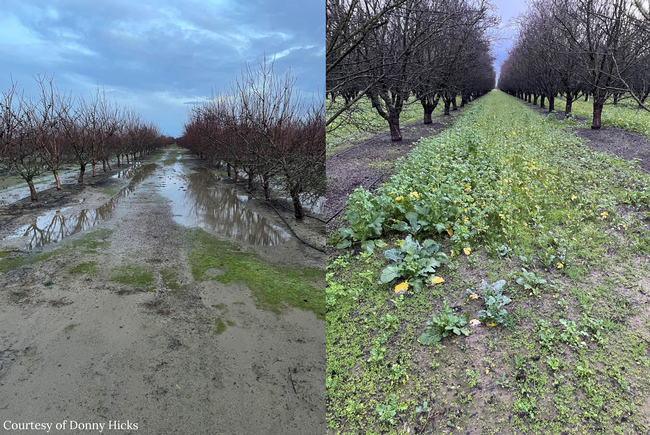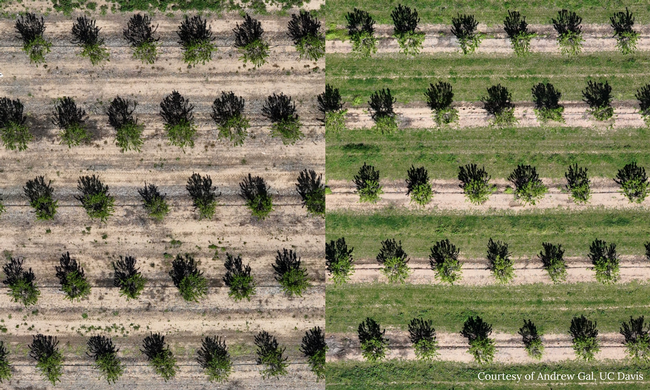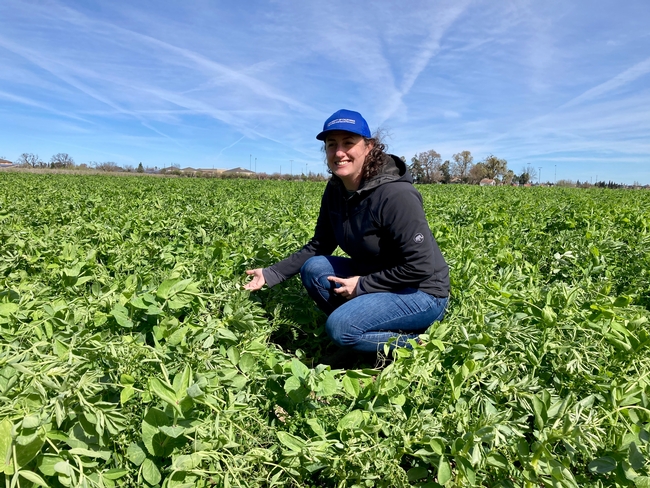Report: Cover crops benefits may outweigh water-use in California
Additional guidance needed for groundwater management strategies
Cover crops are planted to protect and improve the soil between annual crops such as tomatoes or between rows of tree and vine crops, but growers may be concerned about the water use of these plants that don't generate income.
“Cover crops are one of the most popular practices we see farmers employ through our Healthy Soils Program,” said Karen Ross, secretary of the California Department of Food and Agriculture. “Cover crops supply a host of benefits, such as helping to protect against soil erosion, improving soil health, crowding out weeds, controlling pests and diseases, and increasing biodiversity; and they can bring increased profitability as the number of other inputs are reduced. They also provide water benefits such as improved infiltration and reduced runoff.”
These potential benefits are especially salient in the San Joaquin Valley, where groundwater challenges are more acute. A new report evaluates the water implications of cover cropping practices to lay the groundwork for their adoption in the context of the Sustainable Groundwater Management Act, or SGMA, which is intended to protect groundwater resources over the long-term.
“Yes, cover crops require a nominal amount of water to establish – and sometimes rainwater is sufficient – but the myriad co-benefits are worth it,” Ross said.
Growers, water resource planners and managers, crop consultants, irrigation practitioners and policymakers may find the cover crops report useful.
The report is the product of a convening process jointly developed by the California Association of Resource Conservation Districts, CDFA, Natural Resources Conservation Service of California, and University of California Agriculture and Natural Resources, and assembled by nonprofit Sustainable Conservation.
The multidisciplinary group of more than 30 individuals has published “Cover Cropping in the SGMA Era.” The literature review, policy analysis and recommendations pertain to the water impacts of cover crop practices in California's Central Valley under SGMA.
Cover crops and their potential
“Wintertime rain-fed cover cropping does not necessarily significantly increase water losses compared to bare ground in the winter months,” said co-author Daniele Zaccaria, associate professor in agricultural water management for Cooperative Extension at UC Davis. “Cover cropping can significantly improve soil-water dynamics, increasing soil water infiltration and storage and reducing surface runoff.”
To reap the benefits of cover crops using minimal water, Zaccaria said growers will need to know how the plants perform under different conditions.
“We need to develop and implement a coordinated research effort to increase understanding of net water impacts of cover crops under various meteorological conditions – dry, wet, average," he said.
Report findings and recommendations
To understand the potential of cover cropping under SGMA, the report's authors came together to answer the following questions:
- What are the impacts of cover crops on water cycles (both benefits and use)?
- How does SGMA management account for cover cropping and is it capturing cover crop benefits alongside their water use?
- How can we ensure that this practice remains available to growers where and when it makes sense?
This report synthesizes the learnings from the collaborative initiative including 100-plus multidisciplinary experts, a policy analysis, interviews with Groundwater Sustainability Agency (GSA) staff and consultants, and the expertise contributed by its 30-plus authors. In light of these findings, the report advances a series of recommendations aimed at bridging critical knowledge gaps, enhancing the integration of cover crops into policies and incentive programs, and bolstering data infrastructure and other mechanisms to support sustainable groundwater management initiatives.
One vital throughline is the need for additional guidance from the state to support local GSAs in facing the complex challenges of developing and implementing groundwater management strategies for their local watersheds. These measures aim to optimize cover crop integration within SGMA frameworks and promote sustainable water management practices crucial for the region's agricultural resilience and environmental health.
“This report is unique because the university collaborated closely with state agencies and private sector partners to ensure that the different perspectives provided both the best science available as well as viable policy options,” said Glenda Humiston, University of California vice president for agriculture and natural resources. “By taking a comprehensive view, we can advance recommendations for cover crop policy that help us meet multiple goals, manage our natural resources more effectively, and avoid unintended consequences.”
Sarah Light, UC Cooperative Extension agronomy farm advisor, is one of the UC ANR experts who provided science-based information during the convening sessions and co-authored the white paper.
“Cover crops are a valuable soil health practice that can help ensure the resilience of California farms to climate extremes,” said Light. “As we balance the complexities of water and soil management, it is important to understand the role that cover crops play in an annual water budget so that they are not disincentivized in certain parts of the state. This paper can provide guidance to GSAs and policymakers who are charged with implementing SGMA in their regions.”
The report “Cover Cropping in the SGMA Era” can be downloaded for free at https://suscon.org/wp-content/uploads/2024/05/SC-Cover-Crop-SGMA-Report.pdf.
Related research links:
Long-term reduced tillage and winter cover crops can improve soil quality without depleting moisture https://escholarship.org/uc/item/1cr6w7dp
Impacts of winter cover cropping on soil moisture and evapotranspiration in California's specialty crop fields may be minimal during winter months https://californiaagriculture.org/article/108637
Water-related impacts of cover cropping in California https://www.youtube.com/watch?app=desktop&v=mTNLx6LzEt0




